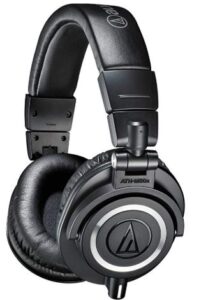Going from one pair of headphones to the other searching for comfort is devastating. It might even push you to give up on using headphones and settle for speakers or earphones instead.
However, you’ll see for yourself that this is not necessary. You simply have to be a little picky with the glasses and the headphones you choose so that you can enjoy a relaxing listening experience. Wondering how to get there? Let us help you figure it out.
- Check out our list of the best Headphones for Glasses – Buyer’s Guide
Contents
How to Wear Headphones with Glasses
Choosing the Right Pair of Glasses
Frame
Choosing the right frame can significantly reduce ear pain while using your headphones. Your goal is to pick the thinnest frame that fits so as to reduce the surface area that’s pressed against your skin, especially that thicker frames make things worse.
Arms
With the arms, you want to keep it straight with no or few patterns. Personally, I find the flatter arms to be more comfortable than the rounded ones because they have smoother edges with less thickness to compress against the ear cartilage and my head bones.
Choosing a Comfortable Headset
Padding Thickness and Material
As you might have guessed, thicker padding is usually more comfortable, offering decent pressure without any itchiness or tenderness.
However, thinking about the padding material is just as important because thick padding that’s made from a harsh material will be problematic as well. The four common materials that are used in making the ear cushions are leather, pleather, velour, and foam.
This is where it gets tricky because the material of the earpads doesn’t only impact comfortability, but it also affects the audio quality. Both synthetic and leather pads form a seal that prevents air leakage.
More often than not, the earpads made from such materials are less thick because there’s more pressure added by the sound itself when it’s trapped inside the earcups.
For this reason, it’s preferable to steer clear from these materials instead of being caught up in this hassle.
Meanwhile, foam and velour are lightweight and softer to keep on the ears for prolonged hours with a pain-free experience even for those who wear glasses. These paddings aren’t as tight; consequently, they’re usually thicker, yet softer on the ears than their leather counterparts.
Clamping Force
The pressure exerted by the headphones on your ears doesn’t only come from the earcups, but from the headset itself as well. Also, the larger the user’s head is, the tighter the headphones will be, which causes even more discomfort for those who wear glasses.
That said, the clamping force of a headset is more or less subjective, so there are no rules here. Yet, there are some tricks that you can resort to in an attempt to loosen up your headphones if you find them too tight. Anyhow, we’ll get to this part later on.
Headphones Features
You may not believe that many headphones manufacturers are already aware that bespectacled users struggle with finding a decent headset, but it’s true.
As a result, some manufacturers incorporated new cushioning techniques that provide more comfort for those who wear glasses. For example, the Turtle Beach Elite Pro 2 and Turtle Beach Elite Atlas headsets feature a ProSpec Glasses Relief System to offer more comfort.
Also, models like Audio-Technica ATH-M50X feature adjustable earcups that can swivel for up to 90 degrees to provide a smoother fit, particularly for spectacles wearers.
Find Audio-Technica ATH-M50x featured in:
- Audio Technica M40x Vs M50x – Which Is The Better One?
- best Headphones For Guitar Amp – Buyer’s Guide
- best Headphones For Transcription – Buyer’s Guide
- best Headphones Under $150 – Buyer’s Guide
Tips and Tricks
Stretch Your Headset
If you already bought a new headset and you can’t bear the strong clipping action, you can try to loosen it by using a small stack of books. Make sure to arrange as many books as it takes to reach the width of your head, then stretch the headphones over the stack whenever you’re not using them.
After a couple of days, you’ll start feeling some improvement. Nonetheless, avoid overstretching the headset, or else you might break it. Also, it’s better to stop using this technique as soon as the headphones start fitting on your ears with ease. Otherwise, you might end up bending them, and they won’t go back to the initial shape.
Reposition the Headphones
If you’re still not comfortable, try finding a relaxed position for the headset. It doesn’t have to be an ideal one, as long as you can keep the headset away from the temple and avoid squeezing your ears along the way.
Another thing that you can try is wearing your glasses over the headphones rather than the other way around. However, this might not work for everyone; it depends on the size of the earpiece and your pain threshold, of course.
Use a Piece of Tissue
If worse comes to worst, you can use a piece of tissue and slide it behind the temples of your glasses to prevent the direct contact between the arms and your skull. This way, you’ll be able to wear the headset for many hours without any discomfort.
Final Thoughts
Headphones are extremely engaging and impressive, which makes them irreplaceable. However, searching for alternatives to using them is never satisfactory. From where I stand, it’s much better to find a way to make it work despite the challenge, and now that you’ve gone through this article, I’m pretty sure it’s easier to sort things out.

